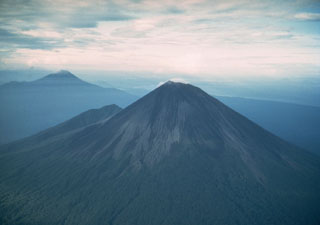Report on Ulawun (Papua New Guinea) — October 1991
Bulletin of the Global Volcanism Network, vol. 16, no. 10 (October 1991)
Managing Editor: Lindsay McClelland.
Ulawun (Papua New Guinea) Seismicity declines without eruption
Please cite this report as:
Global Volcanism Program, 1991. Report on Ulawun (Papua New Guinea) (McClelland, L., ed.). Bulletin of the Global Volcanism Network, 16:10. Smithsonian Institution. https://doi.org/10.5479/si.GVP.BGVN199110-252120
Ulawun
Papua New Guinea
5.05°S, 151.33°E; summit elev. 2334 m
All times are local (unless otherwise noted)
"A buildup of seismicity observed toward the end of September continued through the first week of October, but the volcano remained in a non-erupting state, releasing vapour in small to moderate volumes. The increased seismicity consisted of periods of frequent discrete, low-frequency earthquakes. The maximum daily number of recorded events was ~350. Despite their increase in number, there was no marked increase in amplitude. This activity waned after a week and by the end of the month was at a low level, with earthquake counts of <30/day. High-frequency volcanic earthquakes were recorded occasionally throughout October."
Geological Summary. The symmetrical basaltic-to-andesitic Ulawun stratovolcano is the highest volcano of the Bismarck arc, and one of Papua New Guinea's most frequently active. The volcano, also known as the Father, rises above the N coast of the island of New Britain across a low saddle NE of Bamus volcano, the South Son. The upper 1,000 m is unvegetated. A prominent E-W escarpment on the south may be the result of large-scale slumping. Satellitic cones occupy the NW and E flanks. A steep-walled valley cuts the NW side, and a flank lava-flow complex lies to the south of this valley. Historical eruptions date back to the beginning of the 18th century. Twentieth-century eruptions were mildly explosive until 1967, but after 1970 several larger eruptions produced lava flows and basaltic pyroclastic flows, greatly modifying the summit crater.
Information Contacts: P. de Saint-Ours and C. McKee, RVO.

